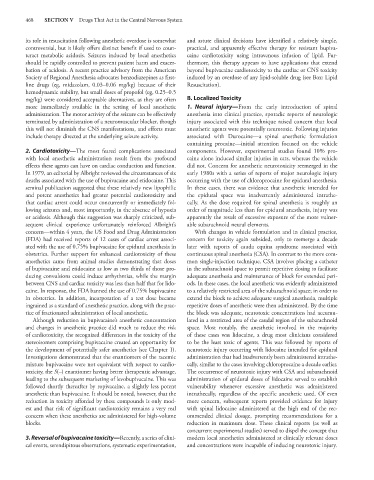Page 482 - Basic _ Clinical Pharmacology ( PDFDrive )
P. 482
468 SECTION V Drugs That Act in the Central Nervous System
its role in resuscitation following anesthetic overdose is somewhat and astute clinical decisions have identified a relatively simple,
controversial, but it likely offers distinct benefit if used to coun- practical, and apparently effective therapy for resistant bupiva-
teract metabolic acidosis. Seizures induced by local anesthetics caine cardiotoxicity using intravenous infusion of lipid. Fur-
should be rapidly controlled to prevent patient harm and exacer- thermore, this therapy appears to have applications that extend
bation of acidosis. A recent practice advisory from the American beyond bupivacaine cardiotoxicity to the cardiac or CNS toxicity
Society of Regional Anesthesia advocates benzodiazepines as first- induced by an overdose of any lipid-soluble drug (see Box: Lipid
line drugs (eg, midazolam, 0.03–0.06 mg/kg) because of their Resuscitation).
hemodynamic stability, but small doses of propofol (eg, 0.25–0.5
mg/kg) were considered acceptable alternatives, as they are often B. Localized Toxicity
more immediately available in the setting of local anesthetic 1. Neural injury—From the early introduction of spinal
administration. The motor activity of the seizure can be effectively anesthesia into clinical practice, sporadic reports of neurologic
terminated by administration of a neuromuscular blocker, though injury associated with this technique raised concern that local
this will not diminish the CNS manifestations, and efforts must anesthetic agents were potentially neurotoxic. Following injuries
include therapy directed at the underlying seizure activity. associated with Durocaine—a spinal anesthetic formulation
containing procaine—initial attention focused on the vehicle
2. Cardiotoxicity—The most feared complications associated components. However, experimental studies found 10% pro-
with local anesthetic administration result from the profound caine alone induced similar injuries in cats, whereas the vehicle
effects these agents can have on cardiac conduction and function. did not. Concern for anesthetic neurotoxicity reemerged in the
In 1979, an editorial by Albright reviewed the circumstances of six early 1980s with a series of reports of major neurologic injury
deaths associated with the use of bupivacaine and etidocaine. This occurring with the use of chloroprocaine for epidural anesthesia.
seminal publication suggested that these relatively new lipophilic In these cases, there was evidence that anesthetic intended for
and potent anesthetics had greater potential cardiotoxicity and the epidural space was inadvertently administered intrathe-
that cardiac arrest could occur concurrently or immediately fol- cally. As the dose required for spinal anesthesia is roughly an
lowing seizures and, most importantly, in the absence of hypoxia order of magnitude less than for epidural anesthesia, injury was
or acidosis. Although this suggestion was sharply criticized, sub- apparently the result of excessive exposure of the more vulner-
sequent clinical experience unfortunately reinforced Albright’s able subarachnoid neural elements.
concern—within 4 years, the US Food and Drug Administration With changes in vehicle formulation and in clinical practice,
(FDA) had received reports of 12 cases of cardiac arrest associ- concern for toxicity again subsided, only to reemerge a decade
ated with the use of 0.75% bupivacaine for epidural anesthesia in later with reports of cauda equina syndrome associated with
obstetrics. Further support for enhanced cardiotoxicity of these continuous spinal anesthesia (CSA). In contrast to the more com-
anesthetics came from animal studies demonstrating that doses mon single-injection technique, CSA involves placing a catheter
of bupivacaine and etidocaine as low as two thirds of those pro- in the subarachnoid space to permit repetitive dosing to facilitate
ducing convulsions could induce arrhythmias, while the margin adequate anesthesia and maintenance of block for extended peri-
between CNS and cardiac toxicity was less than half that for lido- ods. In these cases, the local anesthetic was evidently administered
caine. In response, the FDA banned the use of 0.75% bupivacaine to a relatively restricted area of the subarachnoid space; in order to
in obstetrics. In addition, incorporation of a test dose became extend the block to achieve adequate surgical anesthesia, multiple
ingrained as a standard of anesthetic practice, along with the prac- repetitive doses of anesthetic were then administered. By the time
tice of fractionated administration of local anesthetic. the block was adequate, neurotoxic concentrations had accumu-
Although reduction in bupivacaine’s anesthetic concentration lated in a restricted area of the caudal region of the subarachnoid
and changes in anesthetic practice did much to reduce the risk space. Most notably, the anesthetic involved in the majority
of cardiotoxicity, the recognized differences in the toxicity of the of these cases was lidocaine, a drug most clinicians considered
stereoisomers comprising bupivacaine created an opportunity for to be the least toxic of agents. This was followed by reports of
the development of potentially safer anesthetics (see Chapter 1). neurotoxic injury occurring with lidocaine intended for epidural
Investigations demonstrated that the enantiomers of the racemic administration that had inadvertently been administered intrathe-
mixture bupivacaine were not equivalent with respect to cardio- cally, similar to the cases involving chloroprocaine a decade earlier.
toxicity, the S(–) enantiomer having better therapeutic advantage, The occurrence of neurotoxic injury with CSA and subarachnoid
leading to the subsequent marketing of levobupivacaine. This was administration of epidural doses of lidocaine served to establish
followed shortly thereafter by ropivacaine, a slightly less potent vulnerability whenever excessive anesthetic was administered
anesthetic than bupivacaine. It should be noted, however, that the intrathecally, regardless of the specific anesthetic used. Of even
reduction in toxicity afforded by these compounds is only mod- more concern, subsequent reports provided evidence for injury
est and that risk of significant cardiotoxicity remains a very real with spinal lidocaine administered at the high end of the rec-
concern when these anesthetics are administered for high-volume ommended clinical dosage, prompting recommendations for a
blocks. reduction in maximum dose. These clinical reports (as well as
concurrent experimental studies) served to dispel the concept that
3. Reversal of bupivacaine toxicity—Recently, a series of clini- modern local anesthetics administered at clinically relevant doses
cal events, serendipitous observations, systematic experimentation, and concentrations were incapable of inducing neurotoxic injury.

